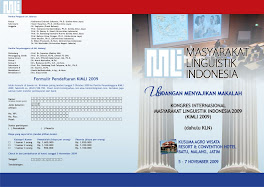LOCALIZED ENGLISH, WHAT ARE ITS IMPLICATIONS ON ENGLISH LANGUAGE TEACHING?
Condro Nur Alim & Sulasih Nurhayati
Abstract
The phenomenon of Englishes (Localization of English) in some countries has become an interesting topic in language studies. The term such as Singlish (Singaporean English) or Manglish (Malaysian English) refers to the ‘unique characteristics’ of English used in those areas. As a result, it may produce the unique variety of English. The term ‘localized’ itself can be simply defined as local characters incorporated in English. Localization, on the other hand may be an attempt to abridge the learners’ difficulties in learning English in native-like way as well as to capture the specific psyche in that local.
Localized English allows the speaker to pronounce English words in a different way from the dictionary. It is also possible for them to be different in accent. As long as they understood each other, they do not need to bother themselves with the ‘correct’ pronunciation and accent. As the consequence the students will not be burdened to speak as closely as native speakers’ accent and pronunciation. It is believed that localized English will give a great encouragement to the students since the difficulties in studying English in native-like way has been minimized by localization.
Localized English also gives a place for local cultures and values tobe incorporated into English language teaching. Therefore, local culture awareness will be another requirements in teaching English in such context.
Since it has been generally accepted as ‘variety of English’ localized English surely has implications on English language teaching. This paper is aimed at exposuring some possible implications of localized English on English language teaching.
Key words: localized, implications, language, teaching
Introduction
English is the language which is used widely among the people around the world. As the consequence, it is unavoidable that certain local characteristics will influence the nature of English in that area. The so-called standard variety of English will be influenced by local language. As the result, a new variety of English –well known as Englishes- will emerge in that region.
In this context, the term of localized English, simply can be understood as the new variety of English in a certain area which is influence by local variety. As this phenomenon has already taken place in many countries such as
Therefore, this paper will discuss about the phenomenon of English localization in term of what are ‘localized’ as well as describing its possible implications in case that localization is generally accepted as the local variation of English.
Englishes Reality
Englishes is a term for recently emerging and increasingly autonomous varieties of English, especially in a non-western setting. This term is used to contrast with the varieties of English spoken in the
In the real world, the number of non-native countries speaking English both as an international communications tool and as local varieties increases significantly. Braj B. Kachru estimated that there is 400 million non-native speakers of English, who are spread all over the world. As English has been used as an auxiliary language in non-native English speaking countries, it has undergone a transplantation in non-American and non-British situations. Consequently, new varieties, styles, registers, and rhetorical models of thinking inevitably emerge, and their authentic and appropriate use in daily conversation cannot be determined and judged by reference to English native speakers, who have become outsiders from the
The phenomenon of Englishes can be found almost in allcountries, for example, such familiar terms as Singlish (Singaporean English), Manglish (Malaysian English), Urrdlish (Urdu English), Japlish (Japanese English), Spanglish (Spanish English), and Hinglish (Hindi English).
Englishes in Literary Works
The local variation of English, actually do not only happen in the daily use of that language, but it has also been used as the language of literary works. The use of local variety of English in many literary works has shown us that Englishes has become our language reality.
Preeta Samarasand, the author of Evening is the Whole Day wrote:
“The English in which I write, is not standard English, but Malaysian English or Manglish, as we call it in Malaysia, and that what actually I meant when I listed interest in ‘Global English’ – I meant English that is not the Queen’s English but that has been transformed/localized to become the native language of people outside England. I’ve argued elsewhere that Manglish is the true ‘native language’ of Malaysia…I think the use of Manglish allows me to capture the Malaysian psyche in a way that no other language would, not even Bahasa Malaysia. (Budianta: 2008)
The following is the example of Manglish in Preeta’s work, that reflects the general characteristics of a local variation of English.
“Chhi!” Amma says, the syllable exploding directly into her mug of tea. “Can’t even be bothered to find a tissue!” If she had listened to your Appa and started packed nicely one moth ago she wouldn’t be in such a mess now, all kacan-mucan running here running there and sniffing and gasping all over the place, isn’t it? (Budianta: 2008)
Another phenomenon of local variation of English in literary work can be found from Moni Mohsin. He is the author of End of Innocence. He wrote as follows:
“My experience is similar to Preeta’s in that though I can read and write both urdu and English, I write only in the latter. And like Preeta,the dialoque that I write is not the Queen’s English, but a mix of English and Urdu, that we call Urdlish. The sensibility of Urdlish is also particular and distinct to Pakistanis, because the language mirrors the culture’ (Budianta: 2008)
Look at the following example of how Urdlish is used in Moni Mohsin ‘The End of Innocence”
“Wimbldeon’s very bore. The women look like khussras. Look at those Venus sisters. (But doesn’t Janoo always say that Venus in the loo in Paris has no arms and yet she has aafat figure? But if she has no arms how does she do backhand?). Maybe these Venus sisters are different. I tau like that blondie Russian wali, Sherpova. Such a nice figure, such long long golden hairs. Wonder where she gets her highlight? Must be from Tony and Gay.
Hai best news tau batana hee bhool gayee. We’re going to london. Janoo’s taken a flat in Baywater. Big concert’s going to be there right next door in Hide Park Concert is for Live Aids ke liye. Kulchoo’s obsessed with it. He’s told me Madonna’s coming. U2 Shu2, Sting vagera, sub Harrods sale is also on and my committee’s out. Gucci chuuchi here I come! (Budianta: 2008)
From above example of Englishes in literary works, both Manglish and Urdlish are characterized by the use of unique vocabularies which are not common in so-called standard English.
Lexical Semantic Localization
The first question to be raised deal with localized English will be: What are actually being ‘localized’? This question will be the basis of the following discussion about the aspects of English which are localized. In this discussion, variety of English in non-native English country will be taken as the example.
In general the aspects of being localized can be categorized in two, they are in vocabulary and phonology.
In the discussion on Pakistani English (PE) Baumgardner (1993) stated that Pakistani language has its own linguistic and cultural identity. The following are some characteristics of Pakistani English, which can also be generalized as the characteristics of other English varieties:
a. Word borrowings: a large number of loan words from Urdu and Regional
languages borrowed freely from indigenous domains of food, clothing,
administration, government, politics, art, education, music and most of all registers of religion.
Words which enter English have become a part of its grammatical system.
b. Word-formations: Another area in which PE has forged its own identity is thatof
word formation, prefixes and suffixes e.g. dc-seat, dc-notify, charge-sheeter and
woolies.
c. Conversion: shift of word for one part of speech to another is another area e.g.
air-craft to air-line (noun to verb conversion)
d. Obsolete vocabulary: use of vocabulary no longer current in BSE e.g
botheration, conveyance, moot etc.
English Phonology Localization
In Indonesian context, Alip (2007) identified English phonology localization among Indonesian people. He said that this deviation is not random but systematic, because local people share similar features of language competence and performance,which influence their English competence and performance. Further, he identified the ‘deviant’ form of phonological phenomenon in both segmental and non-segmental aspects of the language.
- Segmental Alterations
- Final Fortis/Lenis Distinction
Example of localization: the words mop and mob, peck and peg, are pronounced the same
- Missing aspiration
Example of localization: the words pot, top and cot are pronounced without any aspiration.
- Palato alveolar fricatives
Example of localization: the words fish, zoo, and vision are pronounced as [fis], [su:], and [visiən]
- Tense/lax distinction
Example of localization: the words know and so are pronounced as [no] and [so] rather than [nəu] and [səu].
- Suprasegmental Alterations
- Consonant Clusters
Example of localization: the words star and asked are pronounced as [səta:] and [askəd].
- Stress and Rythm
Example of localization: there is no stress and rythm
Implications on English language Teaching
From above discussion it can be assumed that once localization of English is accepted as the local variation of English in a region, there must be implications on English language teaching.
Since the localization can happen both in lexical semantic and phonology, the possible implications on its teaching may cover those two main aspects. Meanwhile, since there is no localization of what so-called standard English grammar, there will be no implication on English grammar teaching.
Dealing with lexical semantic and phonology localization, Setiono (2005) stated that in Indonesian context, both Indonesian teachers and Indonesian students do not really pay serious attention to the accents associated with both American and British English varieties. They instead learn to communicate in English using their local accent, which is typically labeled as ""non-English"" by English native speakers. After all, as one learns and acquires a new language to communicate, the intelligibility of an utterance becomes the prime consideration.
A non-native variety of English therefore accept local content to be incorporated in language production and language use. In this sense, local culture awareness will be an unavoidable aspect to be considered both by language teachers and learners. The assertion of this local culture can be a way to create a more ‘precise’ expression in such particular context.
Final Remarks
As local variety of English has been accepted as a global phenomenon, its emergence is unavoidable as long as the language users in a certain region require it. This is due to the assumption that the language belongs to those who speak it.
Localization, in a more practical term can be an abridgement to reduce the barrier may face by those who are non native English speakers due to their ‘natural’ obstructions. As the consequence, the acceptance of a new variety of English will give implications on language teaching. In a more practical sense, localized English can be an alternative to boost the use of English by incorporating local culture. In order to be accepted as the norm, pedagogical norm change and description and codification of the feature of the language should be the priority.
References










No comments:
Post a Comment